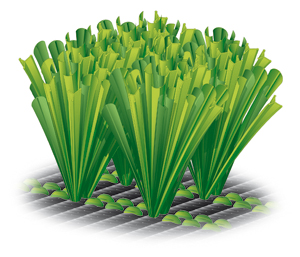
Different production processes
Our products are inspired by nature. This stands for our persistent ambition to develop the most natural-looking synthetic turf in the entire world. That commitment to not only being the best but always moving forward has elevated our brand to the pinnacle of world sport and has become the cornerstone for our continued success as a company.
We have two different ways of producing our products, tufting and weaving. We descibed both processes below.
Weaving technology
One of the most glowing examples of GreenFields innovation comes in the form of our GreenFields MX technology turf product. We hold a patent on our W-Weave technology and there is truly no other artificial turf product like it on the market. What makes it stand out is not simply its ability to provide the best possible playing experience, or its stunningly natural look and feel, but also the fact that it is 100% recyclable as well. No glues or chemical adhesives are used to hold the tufts in place. The W-Weave technology eliminates the need for them entirely. It’s a true industry first that speaks volumes about our commitment to the “Inspired By Nature” concept.
Tufting
Tufting is the traditional way to produce artificial turfs. Tufting is a process where a needle (like a big sewing needle) is pushed through the backing together with the (grass) yarn to form a loop or a pile. A backing is a fabric that forms the the back of the artificial grass carpets. The loops are cut to create individual (grass) piles. After this process the (grass) piles need to be fixed to prevent them from falling out during usage, so a layer of latex is applied to the backside of the backing to fix the piles and provide the backing more rigidity.
